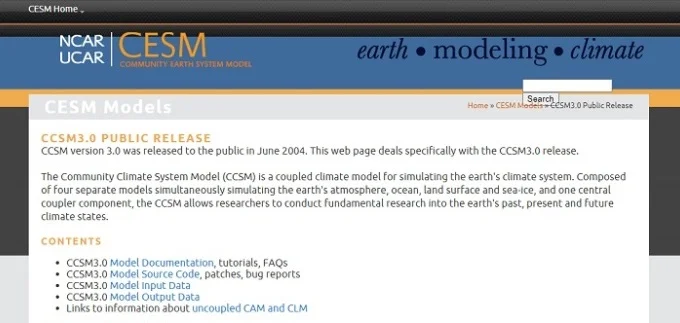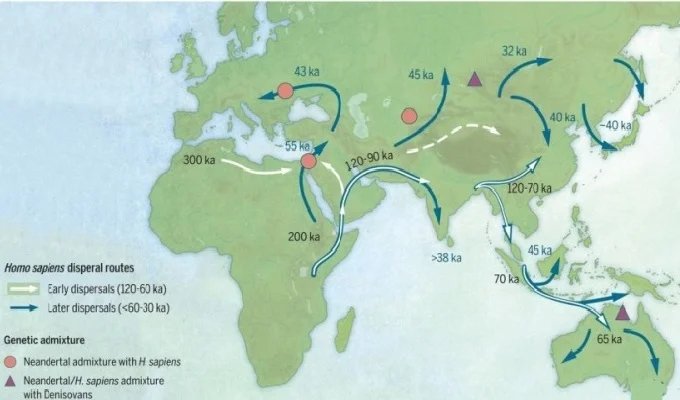How the tilt of the earth changed forced humanity to spread globally

The development of human civilization has always directly depended on climatic changes on the planet. Primitive people first migrated behind herds of animals, providing them with food and clothing, but later the tribes settled in river deltas and on the fertile lands of the foothills. It is the climate, the formation of which is influenced by the inclination of the planetary axis of rotation, that helped mankind to settle practically all over the Earth.
An international team of researchers in order to study climate change has created a computer model of them over the past 140 thousand years. This simulation, which was named CCSM3 (The Community Climate System Model Version 3) and is, by the way, freely available, allowed scientists to study the stages and rates of human settlement around the planet.

The study itself proceeded as follows. Scientists have loaded into a computer model all the data known to science for 140,000 years about changes in the Earth’s orbit, the tilt of its axis, the gas composition of the planet’s atmosphere, the area of glaciers at its poles, and a number of other factors that directly affect the climate. Based on this data, the program recreated a simulation of how the temperature changed over this time and the amount of precipitation in Africa, the Arabian Peninsula, and the Mediterranean region.
Climate, precipitation, and vegetation
These results helped the researchers determine the vegetation amount at separate time intervals in different regions. As a result, it was found that almost all the data obtained using computer simulations coincided with evidence of an ancient climate in the same periods and in the same regions that are known from other sciences.
Computer simulations showed that about 125 thousand years ago, the Earth’s axis of rotation was located at such an angle that the northern hemisphere of the planet was as far away from the Sun in winter as possible, and, on the contrary, in summer, it was as close to the luminary as possible.
As a result, at that time on the Arabian Peninsula and in the modern African Sahara desert, precipitation in the summer was much higher than it is now. This means that 125,000 years ago, these regions, which are today deserted, were covered with dense vegetation.
How a cold snap made people move out
Approximately 70 thousand years ago, the Earth’s axis of rotation changed its angle, which was the beginning of a new “climatic era” in the history of the planet. However, these changes have not been rapid. Over the course of 55 thousand years, the amount of greenhouse gases in the Earth’s atmosphere has been gradually decreasing. Glacier caps at the poles began to increase, which led to global cooling and a significant decrease in precipitation in the equatorial region.

Such climate changes could not but affect the vegetation. The number of forests on the equator began to decline rapidly. Scientists believe that this is what eventually led the ancient people to begin migrating to less arid and cooler zones closer to the poles, where vegetation was abundant. After all, where there are more plants, there are more animals that primitive people hunted at that time.
Following the winter precipitation
At a time when summers became drier in the equatorial region, more and more precipitation began to fall in the Middle East and the Mediterranean in winter. The largest migration of homo sapiens from Africa to Eurasia began about 60 thousand years ago. And although our ancestors made attempts to relocate before that, nevertheless, this expansion became key.
The settling of “Homo sapiens” in the Middle East region, the Arabian Peninsula, the Mediterranean, and further to the North resulted in the gradual disappearance of other types of people who lived in these territories before the arrival of homo sapiens. But the ancestors of modern man did not stop there, sending several dozen species of animals (woolly rhinos, mammoths, cave bears, etc.) to the fossils.
Research continues
The developers of computer modeling and the authors of the study are still objective – their model of temporary changes in climatic conditions on the planet can hardly be called ideal. Some results for certain regions and periods did not coincide very much with the real ones. Scientists are currently busy improving the CCSM3 simulation and adapting it to newer, more powerful (and therefore more accurate) computers.
Be that as it may, almost all researchers nevertheless agree that climate change significantly influenced the migration of early humans. It cannot be argued that the oscillations of the Earth’s axis of rotation were the only reason for the dispersal of homo sapiens around the planet, but we can say with all certainty that they definitely influenced him.
Around the same time when primitive people began to migrate to Eurasia, its indigenous inhabitants – the Neanderthals – continued to explore the northern expanses of the continent. One can only guess how difficult this expansion was into regions with permafrost, long and cold winters, and short summers. Nevertheless, it is now known for certain how the ancient European Neanderthals conquered Siberia.





